

Steps for doing:
- The coloured part in being stretched.
- Hold the right wrist region, with right palm facing the ground
- Left hand holding right wrist region with thumb facing up
- Rotate right forearm with left hand
- Right upper limb in straight line
- Hold the position for 10-20 seconds, without holding your breath
In this video we are going to see Brachioradialis muscle stretching exercise
The coloured part of the muscle is being stretched as shown
The arrow indicates the direction of stretch
- Most important muscle responsible for tennis elbow
- Related to weakness of forearm muscles
- It refers symptoms to the elbow joint, forearm and in the hand region
- Symptoms may include pain, numbness, hypersensitivity, altered sensation, irritability, and also symptoms related to compression of adjacent blood vessels and nerves
- Commonly related to the disease such as de quervains disease, cervical nerve compression(C5 orC6) and various other diseases.
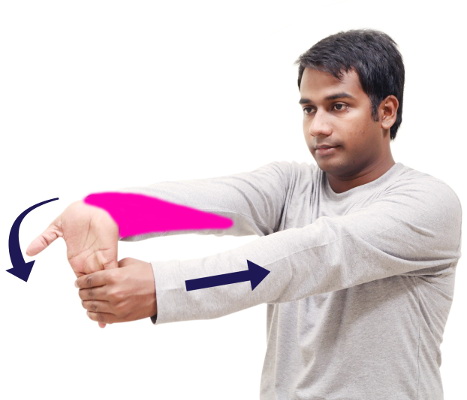
Steps for doing:
- The coloured part in being stretched.
- Hold Right upper limb in straight line with palm facing away from you
- Hold the right hand fingers in tip with left hand as shown
- Pull the right hand fingers posteriorly behind with left hand as shown
- Hold the same position for 10-20 seconds, without holding your breath
In this video we are going to see stretching exercise of Deep flexor muscles of forearm
The coloured part of the muscle is being stretched as shown
The arrow indicates the direction of stretch
- Most important muscle responsible for fine movements of fingers
- It refers symptoms to the forearm, wrist and to all the fingers
- Symptoms may include pain, numbness, hypersensitivity, altered sensation, irritability and symptoms related to compression of adjacent blood vessels and nerves
- Commonly related to the disease such as arthritis of small joints, small joint dysfunction, pronator teres syndrome, carpal tunnel syndrome, and cervical nerve compression.
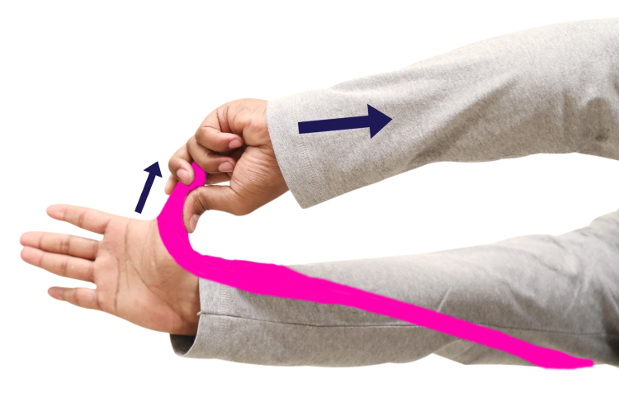
Steps for doing:
- The coloured part in being stretched.
- Hold Right upper limb in straight line
- Hold the right thumb as shown by left fingers
- Right thumb is at right angle to the right index finger
- Pull the right thumb upward and behind with left hand as shown
- Hold the same position for 10-20 seconds, without holding your breath
In this video we are going to see stretching exercise of Flexor pollicis longus muscle
The coloured part of the muscle is being stretched as shown
The arrow indicates the direction of stretch
- Small muscle responsible for disabling symptoms of thumb
- It refers symptoms to the forearm, and thumb region
- Symptoms may include pain, numbness, hypersensitivity, altered sensation, irritability and symptoms related to compression of adjacent blood vessels and nerves
- Commonly related to the disease such as arthritis of wrist and thumb joints, joint dysfunction, epicondylitis, carpal tunnel syndrome, and cervical nerve compression(C6, C7).

Steps for doing:
- The coloured part in being stretched.
- Hold the right palm region, with right palm facing away from you
- Left hand holding right palm from behind
- Rotate right palm with left hand posteriorly behind and upwards
- Right upper limb in straight line
- Hold the same position for 10-20 seconds, without holding your breath
In this video we are going to see Pronator teres muscle stretching exercise
The coloured part of the muscle is being stretched as shown
The arrow indicates the direction of stretch
- Most important muscle responsible for median nerve entrapment
- It refers symptoms to the elbow joint, forearm and in the hand region
- Symptoms may include pain, numbness, hypersensitivity, altered sensation, irritability, and symptoms related to compression of adjacent blood vessels and nerves
- Commonly related to the disease such as epicondylitis, carpal tunnel syndrome, thoracic outlet syndrome, wrist joint dysfunction.

Steps for doing:
- The coloured part in being stretched.
- Hold the right upper limb straight as shown
- Hold right wrist with left hand, and left thumb facing behind
- Rotate the right forearm towards left side, with left hand
- Hold the same position for 10-20 seconds, without holding your breath
In this video we are going to see stretching exercise of supinator muscle
The coloured part of the muscle is being stretched as shown
The arrow indicates the direction of stretch
- These muscles are most commonly involved in screwing and unscrewing movements
- It refers symptoms to the elbow, and the thumb regions
- Symptoms may include pain, numbness, hypersensitivity, altered sensation, irritability and symptoms related to compression of adjacent blood vessels and nerves
- Commonly related to the disease such as epicondylitis, thumb joint dysfunction, carpal tunnel syndrome, de quervain’s disease, cervical nerve compression(C5,C6) and others.
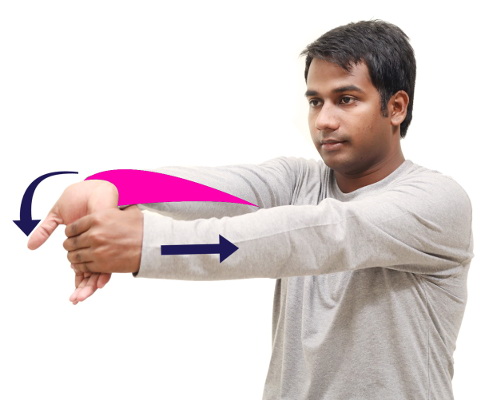
Steps for doing:
- The coloured part in being stretched.
- Hold Right upper limb in straight line with palm facing away from you
- Hold the right palm as shown with left hand
- Pull the right hand posteriorly behind with left hand as shown
- Hold the same position for 10-20 seconds, without holding your breath
In this video we are going to see Wrist flexor group of muscles stretching exercise
The coloured part of the muscle is being stretched as shown
The arrow indicates the direction of stretch
- Most important muscle responsible for fine movements of hand
- It refers symptoms to the forearm, wrist and in the hand region
- Symptoms may include pain, numbness, hypersensitivity, altered sensation, irritability and symptoms related to compression of adjacent blood vessels and nerves
- Commonly related to the disease such as epicondylitis, carpal tunnel syndrome, thoracic outlet syndrome, wrist joint dysfunction, and cervical nerve compression.
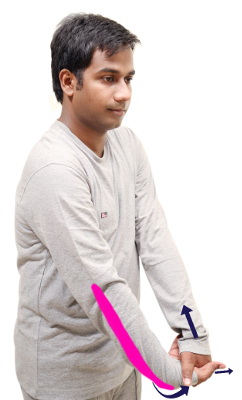
Steps for doing:
- The coloured part in being stretched.
- Hold Right upper limb in straight line
- Right palm facing towards you
- Right thumb facing away from you
- Hold right hand with left hand and pull upwards and push right thumb away as shown
- Hold the same position for 10- 20 seconds, without holding your breath
IIn this video we are going to see stretching exercise of Radial group of muscles
The coloured part of the muscle is being stretched as shown
The arrow indicates the direction of stretch
- This muscle is responsible for painful weak grip of the hand
- It refers symptoms to the elbow, forearm, wrist and hand regions
- Symptoms may include pain, numbness, hypersensitivity, altered sensation, irritability and symptoms related to compression of adjacent blood vessels and nerves
- Commonly related to the disease such as epicondylitis, wrist joint dysfunction, finger arthritis and cervical nerve compression(C6,C7) and others.
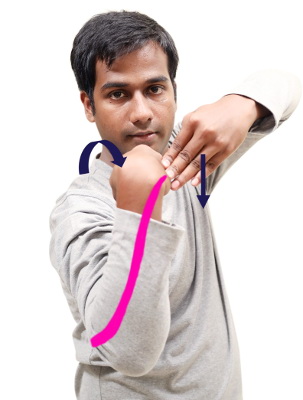
Steps for doing:
- The coloured part in being stretched.
- Right elbow, hand and fingers flexed as shown
- Push the right inner aspect of hand downwards with left hand as shown
- Push the outer aspect of hand downwards with right hand as separate exercise which is not shown here
- Hold the same position for 10-20 seconds, without holding your breath
In this video we are going to see stretching exercise of hand extensor muscles
The coloured part of the muscle is being stretched as shown
The arrow indicates the direction of stretch
- These muscles are most common cause for pain in the back of wrist
- It refers symptoms to the elbow, forearm, wrist, hand and finger regions
- Symptoms may include pain, numbness, hypersensitivity, altered sensation, irritability and symptoms related to compression of adjacent blood vessels and nerves
- Commonly related to the disease such as epicondylitis, wrist joint dysfunction, carpal tunnel syndrome, de quervain’s disease, cervical nerve compression(C7, C8) and small joint arthritis.
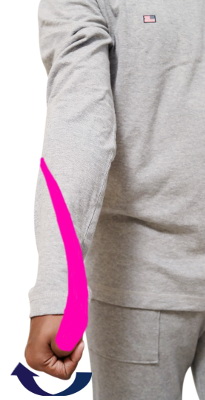
Steps for doing:
- The coloured part in being stretched.
- Hold the right thumb with in the hand closed.
- Pull it behind posteriorly and backwards as shown
- Hold the same position for 10-20 seconds, without holding your breath
In this video we are going to see stretching exercise of deep forearm muscles
The coloured part of the muscle is being stretched as shown
The arrow indicates the direction of stretch
- Muscle responsible for fine motor tasks of the thumb
- It refers symptoms to the hand and thumb region
- Symptoms may include pain, numbness, hypersensitivity, altered sensation, irritability and symptoms related to compression of adjacent blood vessels and nerves
- Commonly related to the disease such as thumb joint dysfunction, arthritis of thumb, de quervain’s disease, and others.
 Brain and Spine Secrets
Brain and Spine Secrets